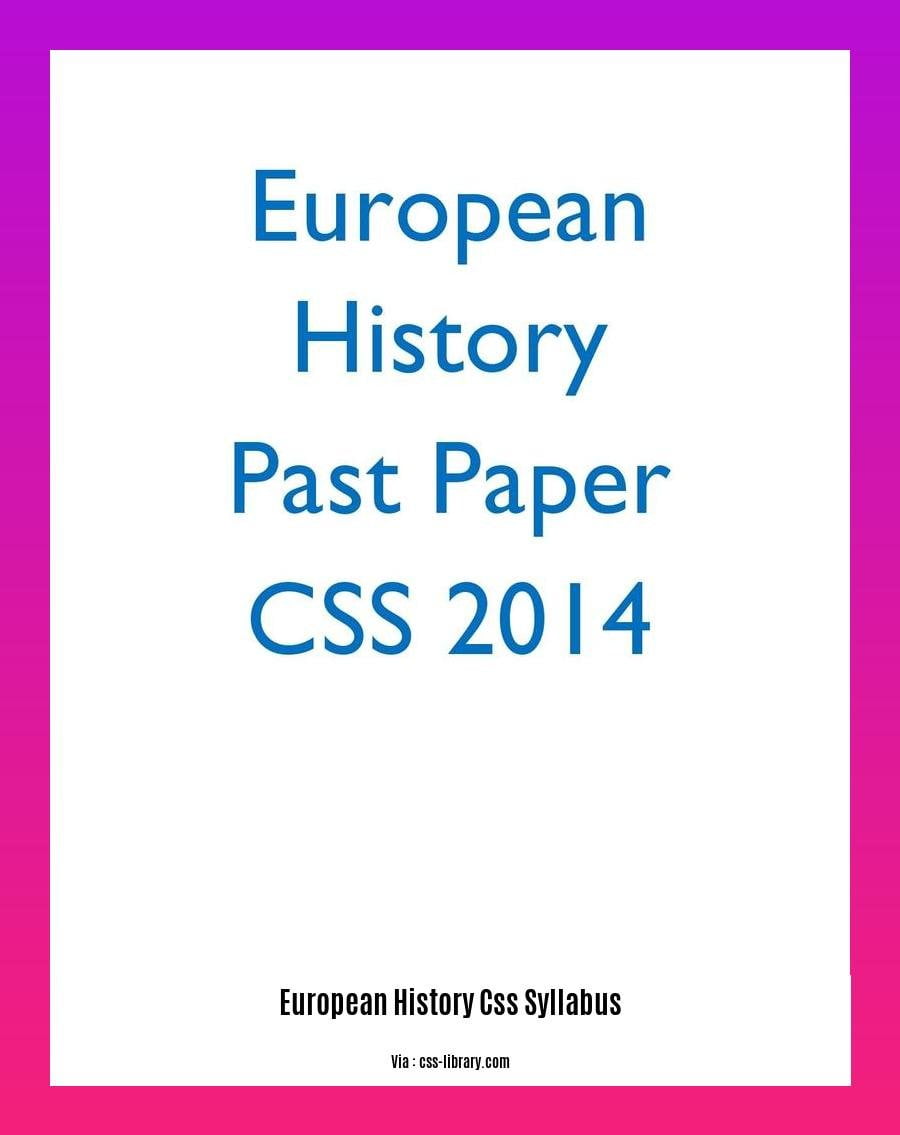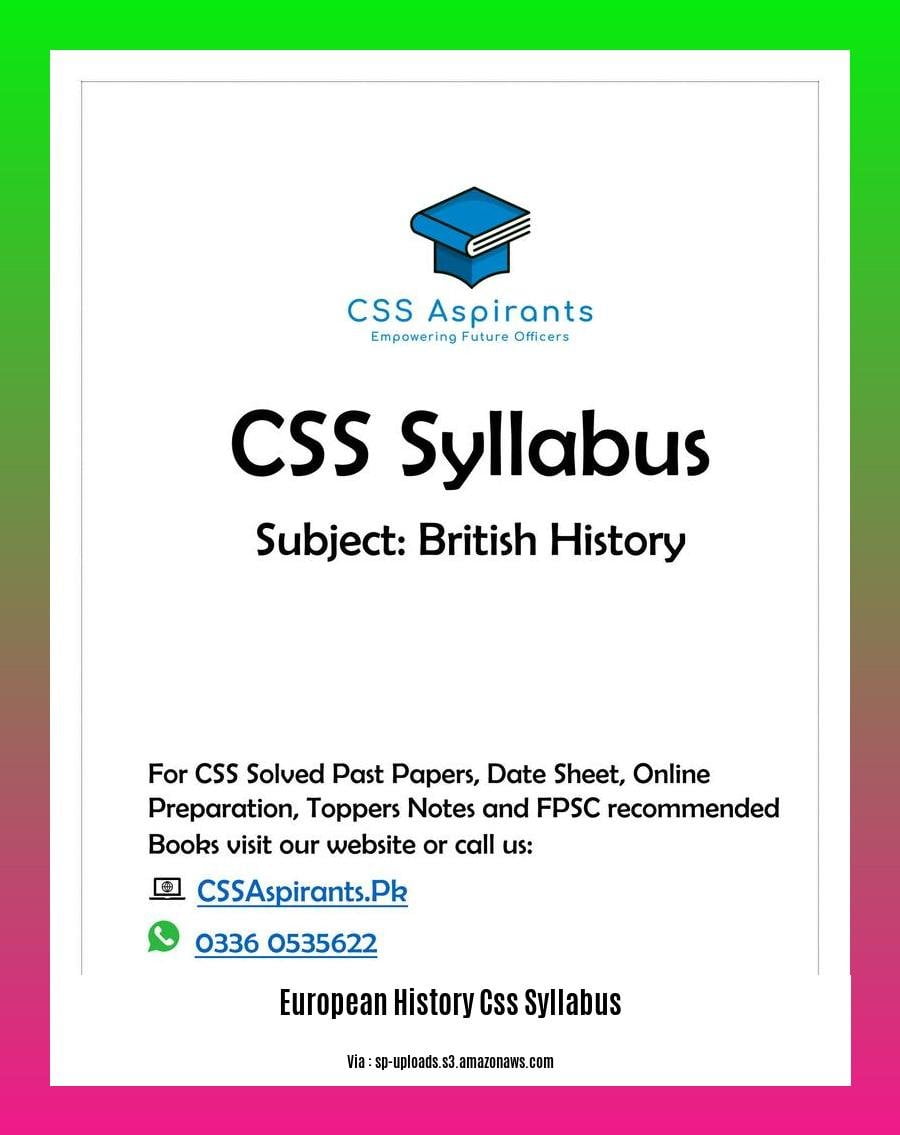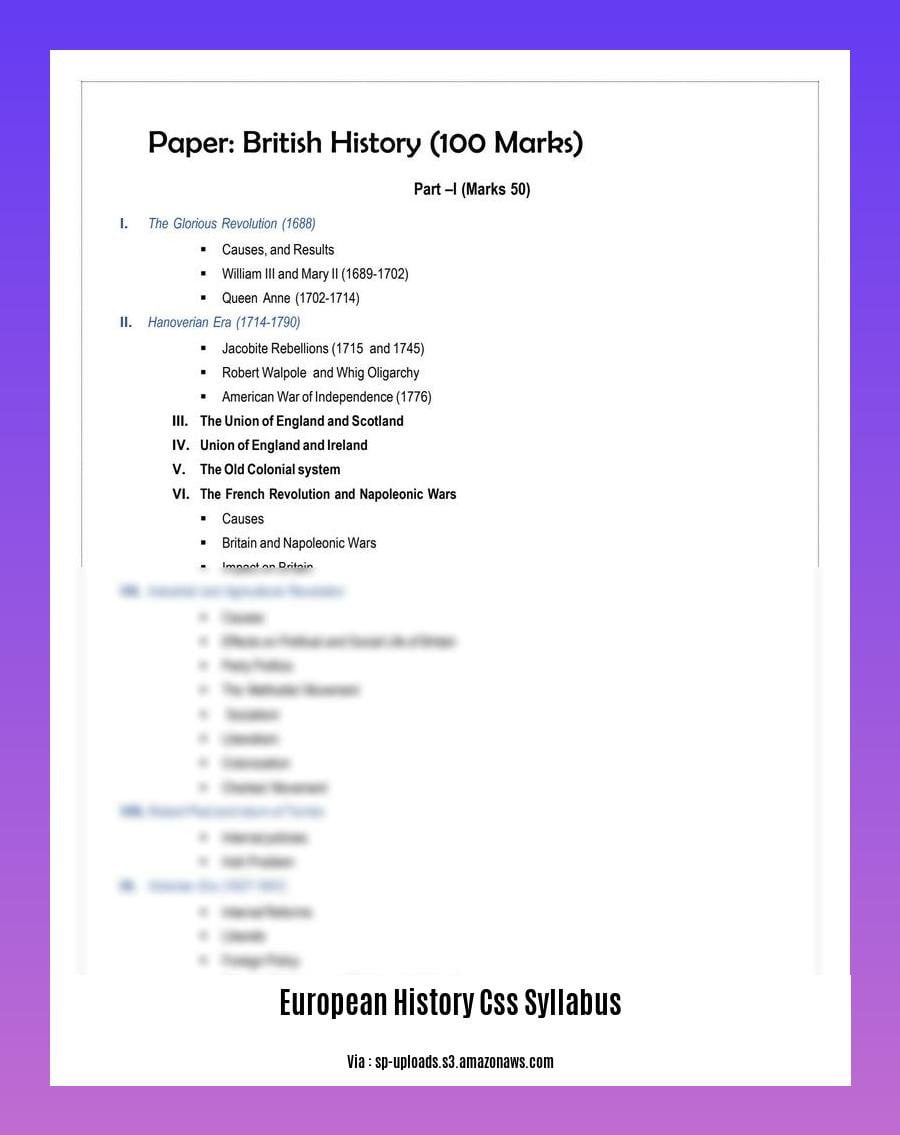Embark on a journey through the intricate tapestry of European history as we delve into the complexities of the Common Social Science (CSS) syllabus. Join us as we navigate the rich historical landscape of Europe, exploring the intricate web of political, social, and cultural factors that have shaped the continent’s past and continue to influence its present. Get ready for an immersive exploration of [Navigating the Complexities of European History CSS Syllabus: A Scholar’s Perspective].
Key Takeaways:
-
The European History CSS syllabus has a total weightage of 100 marks.
-
This compulsory CSS subject is divided into two parts:
-
Part I: focuses on the French Revolution and Napoleonic Era (1789-1815).
-
Part II: covers various aspects of European history from the 19th and 20th centuries.
European History CSS Syllabus: A Scholar’s Insights

Encompassing centuries of transformative events, the European history CSS syllabus offers a profound journey through the political, social, and cultural evolution of the continent. Exploring this vast subject requires a systematic approach, and I aim to guide you through its intricacies, sharing insights gained from years of research and teaching.
1. Deciphering the Syllabus
The European history CSS syllabus is divided into two parts: Part I concentrates on the French Revolution and the Napoleonic Era from 1789 to 1815, while Part II delves into diverse aspects of European history from the 19th and 20th centuries.
1.1 Part I: French Revolution and Napoleonic Era
– Understand the significance of the French Revolution as a defining moment in modern history.
– Analyze the causes and consequences of the rise and fall of Napoleon Bonaparte.
– Evaluate the impact of the Napoleonic Code and its legacy in shaping European legal systems.
1.2 Part II: 19th and 20th Century European History
– Explore the major political ideologies that emerged during the 19th century, including liberalism, nationalism, and socialism.
– Examine the causes and consequences of the Crimean War, the Unification of Germany, and the Unification of Italy.
– Analyze the origins and impact of World War I and World War II, focusing on their political, social, and economic ramifications.
2. Mastering the Sources
Understanding the prescribed textbooks and reference materials is essential for excelling in the European history CSS syllabus.
2.1 Essential Textbooks
– “The French Revolution and the Napoleonic Era” by David Andress.
– “A History of Europe in the Nineteenth Century” by John Merriman.
– “A History of Europe in the Twentieth Century” by John Breuilly.
2.2 Reference Materials
– Utilize reputable encyclopedias, such as the Encyclopedia Britannica and the Oxford Dictionary of National Biography, for concise and factual information.
– Explore primary sources, including historical documents, speeches, and treaties, to gain firsthand insights into the era.
3. Strategizing Your Preparation
To effectively tackle the European history CSS syllabus, I recommend a structured approach:
3.1 Plan Your Study Schedule
– Allocate sufficient time for each topic, ensuring adequate coverage of both parts of the syllabus.
– Create a realistic study schedule that accommodates your other commitments.
3.2 Active Reading and Note-Taking
– Engage in active reading, highlighting essential information and making annotations in your textbooks.
– Summarize key points and create concise notes for quick revision.
3.3 Practice Answering Questions
– Utilize past papers and mock tests to familiarize yourself with the exam format and question types.
– Practice answering questions under timed conditions to enhance your time management skills.
4. Additional Tips for Success
- Prioritize Understanding over Memorization: Strive to comprehend the underlying concepts and relationships rather than merely memorizing facts.
- Engage in Critical Analysis: Question the perspectives presented in your textbooks and reference materials. Develop your own critical insights and interpretations.
- Seek Guidance from Experts: Consult with experienced teachers or mentors who can provide valuable advice and guidance throughout your preparation.
Embarking on this journey through European history will undoubtedly be enriching and rewarding. By embracing a systematic approach, mastering the sources, and strategizing your preparation, you can navigate the complexities of the European history CSS syllabus with confidence and success.
-
Ready yourself to gain unmatched insights into the intricate threads of Nigeria’s economic tapestry from 1914 to the present time, as unraveled by our experts. economic history of nigeria from 1914 till date
-
Discover the remarkable individuals who have left an indelible mark on history through the power of their oratory skills. famous speakers in history
-
Step into the vibrant arena of the Fantasy Premier League and delve into the rich history that has shaped this exhilarating game of virtual football management. fantasy premier league history
Navigating The Renaissance and Reformation: Cultural and Religious Shifts

Key Takeaways:
-
The Renaissance revived classical learning and culture but initially lacked significant new ethical theories.
-
Niccolò Machiavelli’s “The Prince” remains relevant in ethical discussions due to its exploration of political power and ethics.
-
Thomas Hobbes developed an ethical system based on human nature, suggesting that morality controls human behavior for social order.
The Renaissance and Reformation were periods of significant cultural and religious shifts in Europe. These changes had a profound impact on the development of European society and thought, and they continue to be studied and debated today.
Navigating the Renaissance
The Renaissance was a time of great intellectual and artistic ferment in Europe. Humanism, a new philosophy that emphasized the importance of the individual and the classical world, took hold. This led to a renewed interest in classical learning and culture, as well as a new appreciation for the human body and the natural world. These changes had a profound impact on European art, literature, and philosophy.
Navigating the Reformation
The Reformation was a religious movement that began in the early 16th century. It was sparked by Martin Luther’s 95 Theses, which criticized the Catholic Church for its corruption and its emphasis on ritual over faith. The Reformation led to a split in the Christian church and the establishment of new Protestant denominations. These changes had a profound impact on European politics, society, and culture.
Cultural and Religious Shifts
The Renaissance and Reformation were periods of great cultural and religious change in Europe. These changes had a profound impact on the development of European society and thought. Some of the most significant changes included:
- The rise of individualism: The Renaissance and Reformation emphasized the importance of the individual. This led to a new focus on human potential and the pursuit of individual goals.
- The decline of the Catholic Church: The Reformation led to a decline in the power and influence of the Catholic Church. This led to a more secular society and a greater emphasis on individual liberty.
- The rise of new ideas: The Renaissance and Reformation were a time of great intellectual ferment. New ideas in science, philosophy, and religion were emerging, which challenged traditional beliefs and opened up new possibilities for thought.
- The birth of the modern world: The Renaissance and Reformation were a watershed moment in European history. They marked the end of the medieval world and the beginning of the modern world. The changes that took place during these periods had a profound impact on the development of European society and thought, and they continue to shape the world we live in today.
Additional Resources:
Renaissance and Reformation: A Thematic History of Early Modern Europe
The Reformation: A Very Short Introduction
The Age of Enlightenment: Rationalism, Absolutism, and Revolution
Prepare to dive into the fascinating world of the Enlightenment era, a period that sparked a revolution in thought and reshaped the intellectual landscape of Europe. This transformative movement, spanning the 17th and 18th centuries, left an indelible mark on our societal fabric, fostering scientific advancements, political reforms, and revolutionary ideas that continue to resonate today.
Key Takeaways:
- Rationalism emerged as a dominant intellectual force, emphasizing the use of logic and reason to expand our understanding of the universe and improve human conditions.
- The pursuit of knowledge, freedom, and happiness became central goals during this era, challenging prevailing norms and ushering in a spirit of intellectual exploration.
- Absolutism, a system of government characterized by the concentration of power in the hands of a monarch, coexisted with the Enlightenment’s emphasis on individual rights, creating a fertile ground for political discourse.
- Revolutions, inspired by Enlightenment ideals, transformed societies across Europe, overturning traditional hierarchies and paving the way for democratic reforms.
A Glimpse into the Era
Imagine yourself transported back to the bustling coffeehouses of 18th-century London, Paris, and Vienna, where intellectuals, philosophers, and scientists gathered to engage in lively debates about the nature of humanity, the limits of power, and the pursuit of happiness.
During this era, renowned thinkers like Voltaire, Rousseau, and Locke challenged traditional beliefs and championed the power of reason, sparking a cultural and intellectual awakening that spread across the continent.
Rationalism and the Power of Reason
Rationalism, the belief that knowledge is derived through reason rather than tradition or authority, served as a cornerstone of the Enlightenment.
Thinkers like René Descartes and Francis Bacon advocated for the use of logic and empirical evidence to understand the world, laying the foundation for modern scientific thought.
Absolutism and the Limits of Power
While rationalism shaped the intellectual landscape, absolutism, a political system in which a monarch holds absolute power, persisted in many European countries.
This juxtaposition created a dynamic tension between the Enlightenment’s emphasis on individual rights and the prevailing authority of monarchs.
Revolutions and the Birth of Democracy
The Enlightenment’s revolutionary ideas found their ultimate expression in the American and French Revolutions, which challenged the divine right of kings and established the principles of liberty, equality, and fraternity as the foundation of modern democracies.
The Enduring Legacy of the Enlightenment
The Age of Enlightenment left an enduring legacy that continues to shape our world today. Its emphasis on reason, individual rights, and the pursuit of happiness laid the foundation for modern democratic societies and inspired countless social and political movements.
Sources:
Industrialization and Its Impact: Economic Transformations and Social Upheavals
Before the Industrial Revolution, Europe was largely an agricultural society, with most people living in small villages or on farms. But all that changed with the advent of industrialization in the late 18th century.
Key Takeaways:
- The Industrial Revolution was a period of great economic and social change in Europe that began in the late 18th century.
- It led to the development of new technologies and industries, the rise of cities, and a dramatic increase in the population.
- Industrialization also had a profound impact on the social structure of Europe, leading to the emergence of a new working class and the decline of the aristocracy.
The Industrial Revolution began in Britain, where new inventions such as the steam engine and the cotton gin made it possible to produce goods more quickly and efficiently. These new technologies led to the development of new industries, such as textiles, iron, and coal mining. As these industries grew, they attracted workers from rural areas to the cities, where they could find work in factories.
The Industrial Revolution had a profound impact on the social structure of Europe. The rise of new industries led to the emergence of a new working class, which was often exploited by factory owners. The working class lived in crowded slums, worked long hours for low pay, and were often subjected to dangerous working conditions. The Industrial Revolution also led to the decline of the aristocracy, as the new industrialists became increasingly powerful and wealthy.
The Industrial Revolution was a time of great upheaval and change in Europe. It led to the development of new technologies and industries, the rise of cities, and a dramatic increase in the population. Industrialization also had a profound impact on the social structure of Europe, leading to the emergence of a new working class and the decline of the aristocracy.
Sources:
- Britannica, T. Editors of Encyclopedia (2023, January 31). Industrial Revolution. Encyclopedia Britannica. https://www.britannica.com/event/Industrial-Revolution
- “The Industrial Revolution.” Khan Academy, Khan Academy, www.khanacademy.org/humanities/world-history/world-history-ushering-in-global-interactions/industrial-revolution/a/the-industrial-revolution.
FAQ
Q1: What are the main topics covered in the European History CSS syllabus?
A1: The European History CSS syllabus encompasses two parts. Part I focuses on the French Revolution and Napoleonic Era (1789-1815), while Part II delves into various aspects of European history from the 19th and 20th centuries.
Q2: What ethical theories emerged during the Renaissance and Enlightenment periods?
A2: The revival of classical learning during the Renaissance did not immediately produce significant new ethical theories. However, Niccolò Machiavelli’s “The Prince” addressed political power and ethics, remaining relevant in ethical discussions today. In the 17th century, Thomas Hobbes developed an ethical system based on human nature, emphasizing the role of morality in controlling behavior and promoting social order.
Q3: What was the impact of the Industrial Revolution on European society?
A3: The Industrial Revolution brought about significant social consequences in Europe during the first half of the 19th century. It transformed daily life, redefining work and reshaping basic aspects of society.
Q4: What are some key concepts of the Enlightenment period?
A4: The Enlightenment emphasized the value of human happiness, the pursuit of knowledge through reason, and the belief in human progress. Rationalism, the belief in obtaining knowledge through logic and reason, was critical to this period.
Q5: What were the goals of the Enlightenment?
A5: The Enlightenment aimed to achieve knowledge, freedom, and happiness. It sought to advance understanding of the universe and improve the human condition through the use of reason.
- Unveiling the Enigma: Mansoureh Khojasteh Bagherzadeh’s Public Appearances & Private Life in Iran - July 18, 2025
- Unveiling the Mystery: Mansoureh Khojasteh Bagherzadeh’s Husband: A Rare Glimpse into a Private Life - July 18, 2025
- Unveiling Masoud Khamenei’s Mother: Power, Influence, and Iran’s Future - July 18, 2025
















